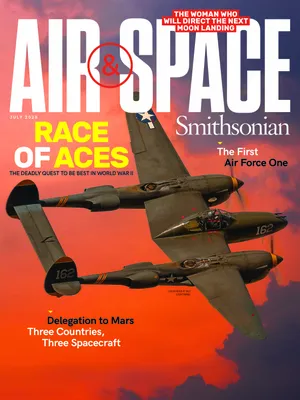Storm Chasers in Outer Space
Scientists hope to develop an early-warning system for hailstorms of radioactive particles.
/https://tf-cmsv2-smithsonianmag-media.s3.amazonaws.com/filer/cd/c5/cdc5d735-ac9d-4536-b782-4ce5ee1b08a9/304flare.jpg)
A new NASA mission to study how the sun creates vast space storms might one day lead to an early-warning system for astronauts threatened by bursts of radiation that periodically flood the solar system.
The $62.6 million project, the Sun Radio Interferometer Space Experiment (SunRISE), is an array of six CubeSats that operate together as one very large radio telescope. Flying within six miles of one another, the toaster-size probes will create 3D maps to pinpoint where giant jets of radiation originate on the sun and how they expand outward into space.
For many years, researchers thought that solar flares were the sources of these bursts of radiation. But the actual culprits are coronal mass ejections (CMEs)—huge gas bubbles threaded with magnetic field lines that are released in the aftermath of a solar flare.
Project lead scientist Justin Kasper, a professor of climate and space sciences and engineering at the University of Michigan, compares the CMEs to compressed springs. “The sun coils up a lot of magnetic field on its surface that can become unstable and rip away,” he says. “The [ejections] go from rest to moving a few million miles an hour in just tens of minutes, as they accelerate away from the sun. Then they start producing really high-energy particle radiation, particles traveling at nearly the speed of light.” This radiation can threaten satellites, astronauts—and, if big enough, disrupt power grids on Earth.
“We’d like to really understand what’s so special about those eruptions that produce the radiation,” Kasper says. “If we could image these radio bursts for the first time, we could actually see where the acceleration happens. Is it the front? Is it the side?”
These findings could one day save the lives of astronauts. “What I’m hoping is that we’ll have a technique where you see one of these bursts begin to form, and then you can pinpoint where on this spiral into the solar system that burst is pointed,” Kasper says. “Are there any planets or spacecraft along that line? This technique should give us the ability to warn people tens of minutes or half an hour beforehand.” That’s long enough to tell an astronaut on the moon or Mars to run and take shelter.
/https://tf-cmsv2-smithsonianmag-media.s3.amazonaws.com/accounts/headshot/mark-strauss-240.jpg)

/https://tf-cmsv2-smithsonianmag-media.s3.amazonaws.com/accounts/headshot/mark-strauss-240.jpg)